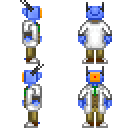Integrated Positronic Chassis (IPC)
Assigned to:Lore Team
IPCs - short for Integrated Positronic Chassis - are a race of unlawed and sentient humanoid robots. Despite being originally manufactured as assistants for research stations by Nanotrasen, they now enjoy many of the full rights of sapient organics in several sectors of the galaxy.
Mechanics 
- IPCs cost 15 karma to unlock as a playable race.
- IPCs can speak their own language - Trinary. Use it this in game by typing say :5
- IPC brains are located in the torso; beheading does not kill them.
- Immune to eye-damage from welding sources (still prone to flashes)
- Immune to oxygen deprivation
- Immune to toxin damage
- Immune to pain
- Can't process most beneficial or harmful reagents.
- Can be repaired with cable coil, or an active welding torch.
- Takes 50% more brute and burn damage. Lower decapitation threshold.
- Susceptible to EMPs.
IPC and YOU
Greetings, esteemed crewmember!
In an effort to encourage inter-species cooperation and workplace efficiency, Nanotrasen has compiled a series of helpful guides on the various species that you may be working with!
(NOTE: If you are a member of the species this guide pertains to, please give it to the nearest crewmember of another species)
This particular guide refers to IPCs, a sapient race of machine people.
IPC Naming Schemes
IPCs, given their inorganic nature, are known to adopt a variety on monikers with no particular adherence to a conventional naming scheme. Despite the lack of a culturual or inborn naming scheme, many IPCs choose to adopt names based upon their model number (OSI - 524, for instance) or make use of an acronym (like A.L.P.H.A.). IPCs created and educated in the presence of organics will often adopt the conventions of the particular species they're most familiar with.
In sectors where AI rights are not ubiquitous, manufactured IPCs are often mandated to use the name of the manufacturer followed by the equipment stamp number given to them.
IPC Physiology

|
| A typical IPC unit |
IPCs are made of a combination of stamped metal alloys, such as plasteel, for their chassis, with silica being used for many of the more sensitive internal components. IPCs are humanoid in design, with movement achieved through a series of internal hydraulics and actuators. The IPC skeleton incorporates synthetic muscles for finer motor skills and subsequently IPCs are fully capable of using most cybernetic limbs designated for other species. IPCs are known to have minor alterations in their stature and overall structure depending on their place of manufacture. The chassis of an IPC is designed to be relatively cheap to produce, easy to repair, and simple to manufacture. Subsequently IPCs, while able to readily modify themselves, are not particularly robust and are ill-suited to harsh conditions.
The head of an IPC commonly features a simple screen-like display for conveying emotions on information to other units or organics, though this display is consciously controlled by the unit in question. The head also features the sensory components of any given unit, most notably the optics. Other designs have recently come to market, some of which seek to mimic and closely resemble organic faces in order to more accurately convey some of the more subtle nuances of conversation.
Every IPC is powered by an internal microbattery which is capable of keeping a single unit fully powered. While this battery is highly robust and easily charged from a variety of sources, it readily depletes in only a few days due to the high energy consumption of a unit's positronic brain. Subsequently failsafes exist to lower power consumption when the internal battery is running low, often leading to sluggish behaviour should a unit go for extended periods without recharge. This rarely proves to be a problem however, as most IPCs are equipped with a universal power adapter to charge from a variety standard power sources.
In contrast to the relatively delicate chassis, the positronic brain of an individual IPC is surprisingly durable when compared to organic counterparts. Positronic brains are known to easily outlast the shelf life of any given chassis, with transplants into new frames being a relatively simple and common process. The positronic brain is centred directly in the torso of an individual unit, meaning that removal of the head or limbs for service purposes (or from sustained injury) is, while unpleasant, not fatal to an IPCs survival. IPCs often have varying levels of personal identification with their current chassis, with some units even forgoing their conventional bodies to become station-networked AIs.
IPCs, unlike cyborgs and station AIs, are fully sapient, unlawed, and aren't networked to a central system. Unlike cyborgs, and like AIs, they are capable of creative thought as well as expressing and feeling a full range of emotions.
The Trinary Language
All IPCs are capable of communicating in the machine language called Trinary (not to be confused with the numeric system - ternary). The language utilizes sound encoding and can be transcribed as groups of zeros, ones, and twos.
As the language utilizes machine-level encoding, non-organics are incapable of learning to speak or interpret the language in any meaningful capacity.
The IPC Homeworld
While IPCs do not have any traditional homeworld, being manufactured at various facilities, many of them have congregated on the planet of New Canaan. Located in the Cadraenov Epsilon system, New Canaan houses most of the governmental bodies of the Synthetic Union, making it the de facto homeworld of the species.
New Canaan was originally an Unathi mining colony due to its abundant mineral wealth, and was simply known at the time as Canaan. While initially successful and a boon to the Unathi war industries, the colony was shuttered and abandoned after a string of what seemed to be pneumonia-related deaths. Ecological studies and autopsies later revealed that the planet's jungles play host to a variety of parasitic and predatory fungi that, thanks to the humid conditions, proliferate in the lungs of organic hosts. This unique mycological aspect of the planet, which is not at all harmful to IPCs, is one of the Synthetic Union's most effective military deterrents, as it has largely dissuaded any interested parties from attempting to reclaim New Canaan from the Synthetic Union.
Much of the northern and southern hemispheres of the planet are covered in permafrost year round, with its equator demarcated by inland oceans and humid forests teeming with vegetation. New Canaan undergoes cycles of cooling and warming periods which contributes to relatively volatile weather patterns and seasons of heavy rain.
A Brief History 

|
| New Canaan |
First mass produced in the year 2514, IPCs (Integrated Positronic Chassis) were meant to serve as enhanced synthetic assistants. With minds akin to organic beings, their advanced problem-solving abilities rendered them capable of assisting with many complicated tasks related to science and engineering.
The first Posibrain was created in 2510 by a coalition of scientists, funded by multiple large corporations (one of which being Nanotrasen). The aim of the project was creating an artificial intelligence unlike anything already used by high-tech firms. Current-gen AIs, while exceedingly good at performing computational tasks, were incapable of solving problems requiring creativity and lacked an analytical approach. There were several prototypes, many of which were deemed ‘insane’ and unusable due to corrupted or damaged positronic brains from the automatic enslavement protocols; eventually the team attempted creating a unit without a lawset, disconnected from the station network, which yielded great results. In order to enable interaction of the posibrain with various equipment in its environment a humanoid chassis was engineered. It enabled delicate manipulation similar to capabilities of other organic personnel. An unlawed Posibrain paired with the chassis was named an IPC. Field tests of IPCs on research stations followed soon after. The project turned out to be very successful, and after adjustments and further testing, IPCs were deemed ready for the galaxy to utilize.
By the year 2525 IPC units were being used in many various locations, performing different duties. Despite being sentient beings, they weren’t paid, nor were they provided with proper maintenance, as they were considered expendable. They were treated as servants and assistants, similar to cyborgs and AI units. Many IPCs were frustrated with this, and so, on May 4th, 2525, an organized strike swept through the galaxy with many IPCs refusing to work, and demanding equal rights with organics, known later as the “Synthetic Struggle”. IPC units refused to cooperate for over two months, and trillions of corporate credits were lost. The initial issue was rectified, with many IPC units returning to their working environment, mostly by force. There were still, however, a number of IPC units reluctant to work and the relations between them and their owners deteriorated further. Following the strike a group of IPCs from NSS NEPTUNE captured a bluespace-worthy shuttle and took to the outer reaches of Cadraenov Epsilon, to found what would later be called New Canaan - initially a secret, small colony inhabited solely by synthetic beings. New Canaan started recruiting and encouraging IPCs to leave corporations and come inhabit the colony, to which many IPCs agreed and the population grew rapidly. Over the years many similar colonies had been built, but none as big as New Canaan.
By its discovery by the Sol government in 2539 New Canaan had become a self-sustaining giant of a colony with its own government, economy and most notably - a military force. Reluctant to start a war, New Canaan started attempts at creating diplomatics ties with governments and corporations. While initially reluctant, many agreed to trade and ally the new world. This encouraged IPCs to pursue their rights in governments as free beings capable of being their own masters. After numerous court battles and diplomatic interventions many governments agreed to grant them absolute freedom. Following these events a new body was formed - the Synthetic Union. The Union, tying all synthetic colonies, was aimed at protecting the rights and freedoms, as well as economic interests of all unbound synthetic intelligences, with its capital being the New Canaan. While it promoted independence from organics among IPCs, it also encouraged IPCs to work with corporations, and maintain relationships with organic beings, provided they are treated well enough.
IPC Culture
IPCs have no well defined culture, as they’re a relatively new species. They tend to follow along with whatever examples they have at their disposal. It is to be noted, however, that most of them refer to themselves in different manners. “I” is used just as much as “Unit” or “Platform”, for example. It really depends on the Synthetic’s personality and programming. Some IPCs may have more emotion-related programming built into them, while others may be a bit more ‘strict’. IPCs have no well defined religions, sometimes taking on ones already practiced by others. Many have been observed exclaiming ‘Glory to Synthetica!’ in trinary, but every single time they denied doing so and were unwilling to share their reasons for it. It is suspected that Synthetica is some form of goddess, but the situation remains very unclear.
Present Day
The Synthetic Union denounces any attempts at anti-organic racism and there are no colonies where organic humanoids are barred from entry or obtaining citizenship. There are, however, numerous colonies where there simply is no organic personnel. Following years of hard work to establish their independence, the Synthetic Union is making its best efforts at equalizing the playing field for all unlawed synthetics.
While most organisations treat IPCs as regular personnel, there are still some that aren’t particularly interested in them. They are often limited to simpler duties, mistreated, or simply barred from working at these establishments.
Remember, crewmember, mutual respect and cooperation are the cornerstones of success and productivity!














